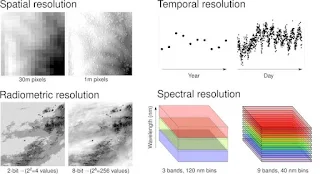When we use satellites or drones to take pictures of the Earth, we talk about different types of "resolutions." These help us understand how clear, detailed, and frequent those pictures are. There are four main types:
1. Spatial Resolution – How small can you see?
-
It tells us the size of the smallest object we can see in the image.
-
It depends on the pixel size. Smaller pixels = more detail.
-
Example: If the resolution is 10 meters, each pixel shows a 10m × 10m area on the ground.
-
Higher spatial resolution means you can see things like buildings and roads clearly.
🟩 Think of zooming in on Google Maps — more zoom = better spatial resolution.
2. Spectral Resolution – How many colours can you see?
-
It tells us how many types of light (or wavelengths) the sensor can detect.
-
Better spectral resolution means it can tell the difference between more materials (like water, soil, and vegetation).
-
It's like being able to see not just red, green, and blue — but also special colours we can't see with our eyes (like infrared).
🖼️ More spectral bands = better for identifying what's what in the image.
3. Radiometric Resolution – How many shades of brightness?
-
This tells us how sensitive the sensor is to light or energy.
-
It measures how many brightness levels the image can show.
-
Example: An 8-bit image can show 256 shades of grey, while a 16-bit image can show 65,536 shades!
🌓 Higher radiometric resolution = you can see finer differences in brightness, like shadows or slight color changes.
4. Temporal Resolution – How often are pictures taken?
-
This tells us how often the satellite passes over the same place and takes a new image.
-
Useful for monitoring changes — like how crops grow, how a city expands, or tracking floods.
-
Some satellites take images daily, others take them once every few days or weeks.
📅 Just like taking photos of a plant every day to see how it grows — that's good temporal resolution.
| Resolution Type | Meaning | Example/Use |
|---|---|---|
| Spatial | Smallest detail visible | Seeing individual trees or houses |
| Spectral | Types of light/colors detected | Telling grass from water |
| Radiometric | Brightness detail | Seeing small changes in shade |
| Temporal | How often images are taken | Watching a field grow over time |

Comments
Post a Comment